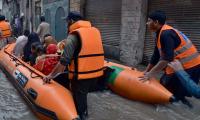The brutal treatment meted out to Farooq Ahmad Dar, the 24-year-old Kashmiri who was beaten up by Indian security forces and then tied to a jeep and dragged through the streets, was supposed to be a turning point in the domestic and international perception of the Indian occupation. The video of the incident went viral and there was enough outrage in India to force the government to allow an FIR to be filed against him. There was also international condemnation of the Indian army using an innocent man as a human shield in such a way. But now any hope that this might have represented a turning point has been lost. The secretary general of the BJP has actually praised the soldier for tying Dar to his jeep, saying “everything is fair in love and war” and claimed the action saved hundreds of military and civilian lives. And the Indian army chief’s promises to take action against the soldiers responsible for tying the Kashmiri man to the jeep were followed by a warning that anyone found stone-throwing would be the target of the operations. So one of the world’s largest military forces finds rocks and stones to be the biggest threat it faces. It is tempting to say that this represents a new low for India but the truth is it had long sunk to the bottom. This is a clear example of how the occupiers dehumanise those they are occupying and in the end lose whatever shreds of humanity they had left.
Not that there should be any need to make the moral case against human shields, but it should be pointed out that the greatest threat to peace comes not by protesters throwing rocks and stones but by the men in uniform who are responsible for the vast majority of killings in Kashmir. Using human shields is considered a violation of the Geneva Conventions and has been classified as a war crime. The first known use of human shields was in Poland by Nazi Germany. It has since been used by various occupying forces such as Israel’s. There have long been reports that the Indian occupying army was using human shields but Dar’s video was the first proof of India’s criminality. Dar himself was only trying to vote in the recent by-election and was not even throwing rocks. Predictably, he has now said he will never vote again. This is how India has forced even the most apolitical Kashmiris to resist the occupation. How can India seriously hope for an end to protests in Kashmir if it continues to act with such impunity? The international observations on this incident are welcome but we wonder how effective and genuine they are since Kashmir has been suffering consistently – as a largely forgotten ‘conflict area’.
India seems to be following Israel model of carrying out assassinations on foreign soil of people it sees as a threat...
Back in January, relations between Iran and Pakistan also suffered a blow when Iran carried out unprovoked air strikes...
Pakistan is only country seen posting double-digit inflation in next two years – 25% in 2024 and 15% in 2025, with...
Recent mayhem happen over two separate incidents, leading to the death of at least 11 people
Now the ISPR has come out with a definitive statement, saying that the Pakistan Army and the Punjab Police have...
The new wave of development has made more countries adopt policies that are not climate-friendly







